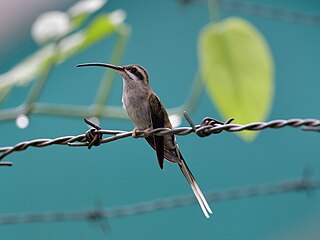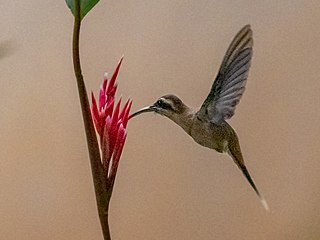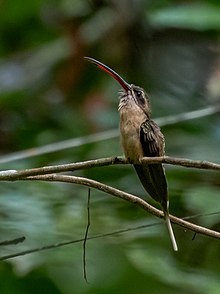
The sooty-capped hermit is a species of bird in the family Trochilidae, the hummingbirds. It is found in Brazil, Colombia, French Guiana, Guyana, Suriname, and Venezuela.

The hermits are tropical and subtropical hummingbirds in the subfamily Phaethornithinae, comprising 37 species in six genera. They occur from southern Mexico, through Central America, to South America as far south as northern Argentina.

Phaethornis is a genus of hummingbirds in the hermit subfamily, Phaethornithinae. They occur from southern Mexico, through Central America, to South America as far south as northern Argentina.

The long-billed hermit is a bird in the family Trochilidae, the hummingbirds. It is found from central Mexico south through Central America, Colombia and Ecuador into Peru.

The long-tailed hermit is a large hummingbird that is a resident breeder in Venezuela, the Guianas, and north-eastern Brazil. This species was formerly referred to as the eastern long-tailed hermit.

The pale-bellied hermit is a species of hummingbird in the family Trochilidae. It is found in Colombia, Panama, and Venezuela.

The black-throated hermit is a species of hummingbird in the family Trochilidae. It is found in Colombia, Ecuador, and Peru.

The straight-billed hermit is a species of bird in the family Trochilidae, the hummingbirds. It is found in Brazil, Colombia, Ecuador, French Guiana, Guyana, Peru, Suriname, and Venezuela.

The scale-throated hermit is a species in the hummingbird family Trochilidae. It is found in Argentina, Brazil, and Paraguay.

The grey-chinned hermit is a species of hummingbird in the family Trochilidae. It is found in Brazil, Colombia, Ecuador, Peru, and Venezuela.

The white-bearded hermit is a species of hummingbird in the family Trochilidae. It is found in Bolivia, Brazil, Colombia, Ecuador, Peru, and Venezuela.

The cinnamon-throated hermit is a species in the hummingbird family Trochilidae. It is found in Bolivia and Brazil.

The needle-billed hermit is a species of hummingbird in the family Trochilidae. It is found in Bolivia, Brazil, and Peru.

The reddish hermit is a species of bird in the family Trochilidae, the hummingbirds. It is found in Bolivia, Brazil, Colombia, Ecuador, Peru, Venezuela, and the Guianas.

The streak-throated hermit, also known as the Rupurumi hermit, is a species of hummingbird in the family Trochilidae. It is found in Brazil, Colombia, Guyana, and Venezuela.

The white-browed hermit is a species of hummingbird in the family Trochilidae. It is found in the Andean foothills and adjacent lowlands in Bolivia and Peru. Its natural habitat is subtropical or tropical moist lowland forest.

The buff-bellied hermit is a species of bird in the family Trochilidae, the hummingbirds. It is found in Bolivia and Brazil.

The planalto hermit is a species of hummingbird. It is found in Argentina, Bolivia, Brazil, Paraguay, and Peru.

The rufous-rumped foliage-gleaner is a species of bird in the Furnariinae subfamily of the ovenbird family Furnariidae. It is found in Bolivia, Brazil, Colombia, Ecuador, French Guiana, Guyana, Peru, and Suriname.

The moustached wren is a species of bird in the family Troglodytidae. It is found in Bolivia, Brazil, and Peru.






















